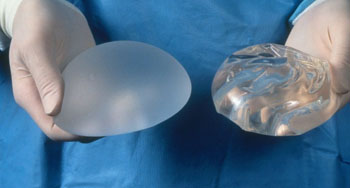Tissue Properties Should Direct Breast Implant Selection
By HospiMedica International staff writers
Posted on 11 Nov 2016
A new study concludes that tissue-based planning (TBP) is the superior approach to primary breast augmentation implant size selection.Posted on 11 Nov 2016
Researchers at the University of Texas (UT) Southwestern Medical Center (Dallas, USA) and McMaster University (Hamilton, Canada) conducted a literature review of the methods used by plastic surgeons to select the appropriate implant size for primary breast augmentation surgery. The implant size selection systems were divided into three groups:

Image: Silicone and saline breast implants side by side (Photo courtesy of Science Photo Library).
• Implants chosen based solely on the patient's or surgeon's preference.
• Implants chosen using dimensional analysis systems in order to establish a desired result.
• Implants chosen using TBP, with measurements used to set clear boundaries for implant selection based on clinical guidelines, with limited to no flexibility.
The researchers reported that while 33 implant size selection systems were included in the final analysis, only four reported clinical outcomes that could be compared to accepted literature values or industry standards. The articles that described TBP systems were of highest methodologic quality, when compared to those that stressed desire of the patient and/or surgeon, and those that did not use breast measurement. The study was published in the November 2016 issue of Plastic and Reconstructive Surgery.
“The top ten studies based on methodological quality all used patients' breast dimensions before selecting final implant dimensions, and this should now be considered standard of practice based on our analysis,” concluded study authors William Adams Jr. MD, and Daniel Mckee, MD. “Going forward, new published systems should use rigorous quantitative methods so that comparisons can be made in terms of patient outcomes.”
A breast implant is a prosthesis used to change the size, shape, and contour of a woman’s breast. There are three general types of breast implantw, defined by their filler - saline solution, silicone gel, and composite filler. The saline implant has an elastomer silicone shell filled with sterile saline solution during surgery; the silicone implant has an elastomer silicone shell pre-filled with viscous silicone gel; and the alternative composition implants featured miscellaneous fillers, such as soy oil, polypropylene string, etc. Composite implants are banned in the United States and Europe due to associated health risks and complications.
Related Links:
University of Texas (UT) Southwestern Medical Center
McMaster University














